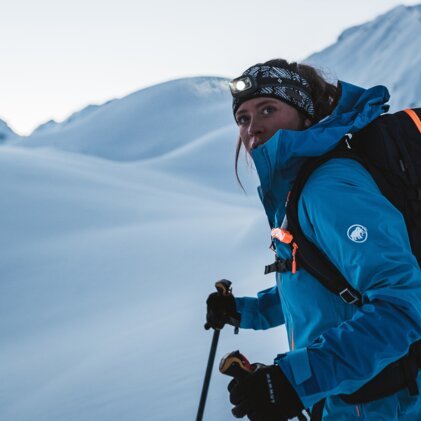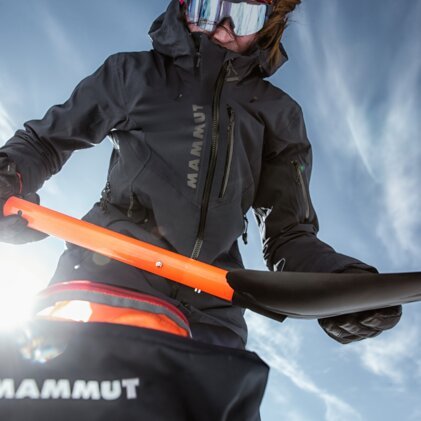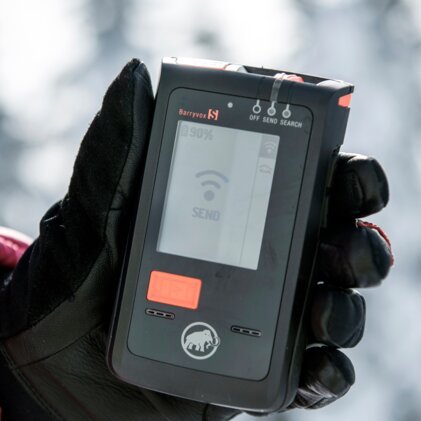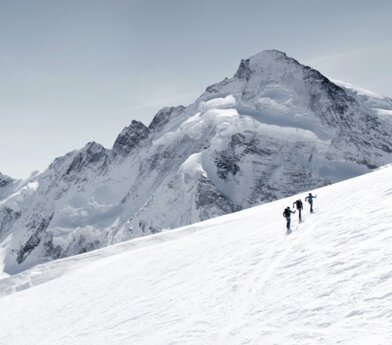Backpack, avalanche transceiver, probe, shovel and more
*Advertisement
You’ve found the perfect ski touring equipment, and you are also completely satisfied with your outfit? Then all that's missing is avalanche equipment because with it ski touring becomes a lot safer – that’s for sure.
But what does an avalanche set consist of? Our RENTertainers know what items belong in your backpack and are happy to share this knowledge with you.
Please don’t forget: Having an avalanche set with you is great. Checking the weather conditions in advance, including the current avalanche report, and knowing your limits is even better.
Avalanche backpack
If you've ever read up on avalanche backpacks, you're probably familiar with the Brazil nut or muesli effect: When you shake a packet of muesli or nuts, the biggest pieces always end up on top. Avalanche backpacks – and the airbags they contain – work in a similar way.
In the event of an imminent burial, the airbag must be activated immediately using the manual pull, which is usually located on the shoulder strap. After that, everything happens pretty quickly: Within two to three seconds, the airbag inflates and creates up to 170 litres more volume.
The result: The person caught in an avalanche gets lifted towards the surface of the snow and ideally won’t be buried.
Depending on the size of the avalanche backpack you choose, it offers space for a spare set of clothing, snacks and, of course, a probe and shovel.
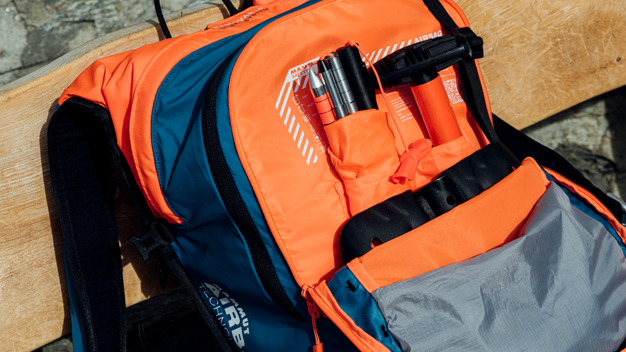
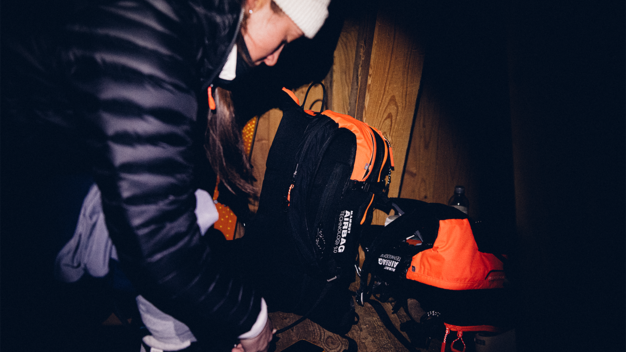
Avalanche transceiver
The avalanche transceiver is a combined transmitter and receiver that is worn on the body. In an emergency, the arrows on the display of the avalanche transceiver guide you to the buried victim. The latest models are digital three-antenna devices that ensure better localisation compared to the analogue original avalanche transceivers. They guide you more intuitively and thus more quickly to the buried victim – and rescuers will have an easier time finding you as well.
Avalanche probe
After the avalanche transceiver has given you the approximate location of the victim, an avalanche probe is used to precisely locate the buried person. It also provides information about the depth at which the victim is located. As soon as the exact location has been determined, digging can begin. Meanwhile, the probe remains stuck in the snow and serves as orientation.
Particularly helpful: Thanks to the labels on the probe, you can better determine the point where the buried victim is closest to the surface. This allows you to dig more efficiently with the avalanche shovel.
Avalanche shovel
Once the buried person has been located with the help of your avalanche transceiver and the probe, you can start digging them out. It is important to act quickly and sensibly – because in the event of a burial, every second counts. The avalanche shovel is your most trusted friend and helper in this phase of the rescue process. Avalanche snow is very compact, and digging with your hands alone won’t get you very far. The avalanche shovel helps you to free the buried person as quickly and efficiently as possible.
What makes a good avalanche shovel?
Although avalanche shovels are seemingly simple items, small details can make a big difference:
- T-grips are lighter and thus easier to handle than D-grips, which in turn are more efficient. The solution: hybrid models.
- You should be able to adjust the handle. The advantage: a smaller pack size along with greater leverage.
- Not too small and not too big, and with sufficiently high sides: That’s what best describes the optimal shape of a shovel blade. The blade’s edge must be just sharp enough to easily penetrate hard and icy snow layers.
- Why just get a shovel when you can also get an ice axe and a snow saw all in one: Different attachments make it easy to convert selected models and use them for multiple purposes.
Other safety accessories
In addition to an avalanche transceiver, probe and shovel, you should also make room in your avalanche backpack for other items that provide extra safety in the event of an emergency.
First aid kit
A trusty first aid kit should accompany you year-round during your outdoor activities. You can use it to treat small but often painful and potentially dangerous wounds such as open blisters. An aluminium rescue blanket prevents you from getting cold. If you already have a first-aid kit for your mountain tours in summer, take it out of your hiking backpack and put it in your avalanche backpack.
Bivy sack
Another companion that is in season all year round is a bivouac sack. Whenever wind and low temperatures start to threaten your health, it is more effective than any piece of functional clothing. The reason: A bivy sack creates a warming air cushion around you and reduces the wind chill effect, which causes the surface temperature of your body to drop.
Complete avalanche sets
By optimally combining the components of your avalanche equipment, namely avalanche backpack, avalanche transceiver, probe and avalanche shovel, you not only protect yourself. Buried victims can usually be rescued within a very short time.
If you prefer 3-in-1 solutions to individual components, then you might want to opt for a complete avalanche set. The advantage: The sets of renowned brands are put together by experts. This saves you time researching the individual items, and you get everything from a single source.
The complete range of ski touring equipment at INTERSPORT Rent
By getting an avalanche set, you’ve already taken the first step towards a safe off-piste experience while ski touring. To tackle your next tour perfectly geared up, you also need the right equipment.
Touring skis with matching bindings and skins, touring boots and touring poles are all part of the basic equipment. An indispensable essential in terms of safety is a ski touring helmet, which should be with you on every tour. If you’ve also picked the right outfit, you are ready for the backcountry!

